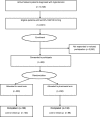A randomized controlled trial of team-based care: impact of physician-pharmacist collaboration on uncontrolled hypertension
- PMID: 18815843
- PMCID: PMC2596500
- DOI: 10.1007/s11606-008-0791-x
A randomized controlled trial of team-based care: impact of physician-pharmacist collaboration on uncontrolled hypertension
Abstract
Objective: Evaluate the effectiveness of collaborative management of hypertension by primary care-pharmacist teams in community-based clinics.
Study design: A 12-month prospective, single-blind, randomized, controlled trial in the Providence Primary Care Research Network of patients with hypertension and uncontrolled blood pressure.
Methods: As compared to usual primary care, intervention consisted of pharmacy practitioners participating in the active management of hypertension in the primary care office according to established collaborative treatment protocols. At baseline, there was no significant difference in blood pressure between groups. Primary outcome measures were the differences in mean systolic and diastolic blood pressures between arms at study end. Secondary measures included blood pressure goal attainment (<140/90 mmHg), hypertension-related knowledge, medication adherence, home blood pressure monitoring, resource utilization, quality of life, and satisfaction.
Results: A total of 463 subjects were enrolled (n = 233 control, n = 230 intervention). Subjects receiving the intervention achieved significantly lower systolic (p = 0.007) and diastolic (p = 0.002) blood pressures compared to control (137/75 mmHg vs. 143/78 mmHg). In addition, 62% of intervention subjects achieved target blood pressure compared to 44% of control subjects (p = 0.003). The intervention group received more total office visits (7.2 vs. 4.9, p < 0.0001), however had fewer physician visits (3.2 vs. 4.7, p < 0.0001) compared to control. Intervention subjects were prescribed more antihypertensive medications (2.7 vs. 2.4, p = 0.02), but did not take more antihypertensive pills per day (2.4 vs. 2.5, p = 0.87). There were minimal differences between groups in hypertension-related knowledge, medication adherence, quality of life, or satisfaction.
Conclusions: Patients randomized to collaborative primary care-pharmacist hypertension management achieved significantly better blood pressure control compared to usual care with no difference in quality of life or satisfaction.
Figures
References
-
- Association of American Medical Colleges. Recent Studies and Reports on Physician Shortages in the U.S. Association of American Medical Colleges; 2007 August.
-
- None
- Merrit J, Hawkins J, Miller P. Will the last physician in america please turn off the lights? A look at America’s looming doctor shortage. Irving: The MHA Group; 2004.
-
- Health Resources and Services and Administration (HRSA). Physician Supply and Demand: Projections to 2020. Health Resources and Services and Administration (HRSA); 2006 October.
-
- Council on Graduate Medical Education. Physician Workforce Policy Guidelines for the U.S. for 2000–2020. US Department of Health and Human Services; 2005.
-
- {'text': '', 'ref_index': 1, 'ids': [{'type': 'DOI', 'value': '10.1016/j.amjcard.2006.12.084', 'is_inner': False, 'url': 'https://doi.org/10.1016/j.amjcard.2006.12.084'}, {'type': 'PubMed', 'value': '17493485', 'is_inner': True, 'url': 'https://pubmed.ncbi.nlm.nih.gov/17493485/'}]}
- Greenberg JO, Greenberg H. More physicians are not the answer. Am J Cardiol. 2007;99(10):1476–8, May 15. - PubMed
Publication types
MeSH terms
LinkOut - more resources
Full Text Sources
Other Literature Sources
Medical
Research Materials


